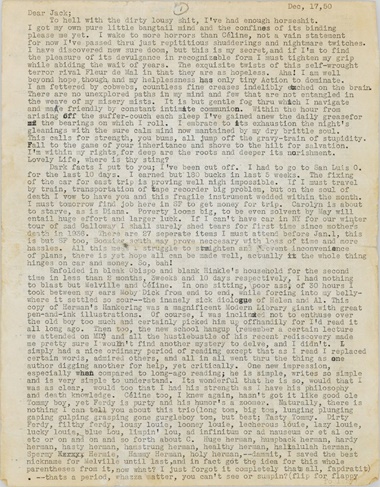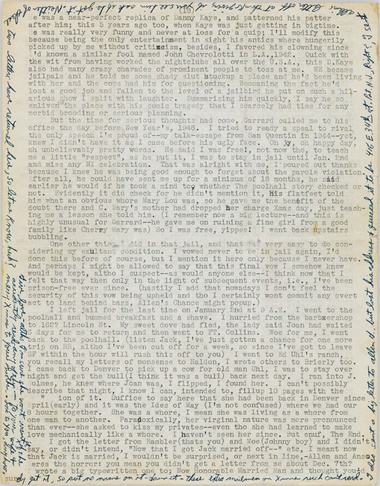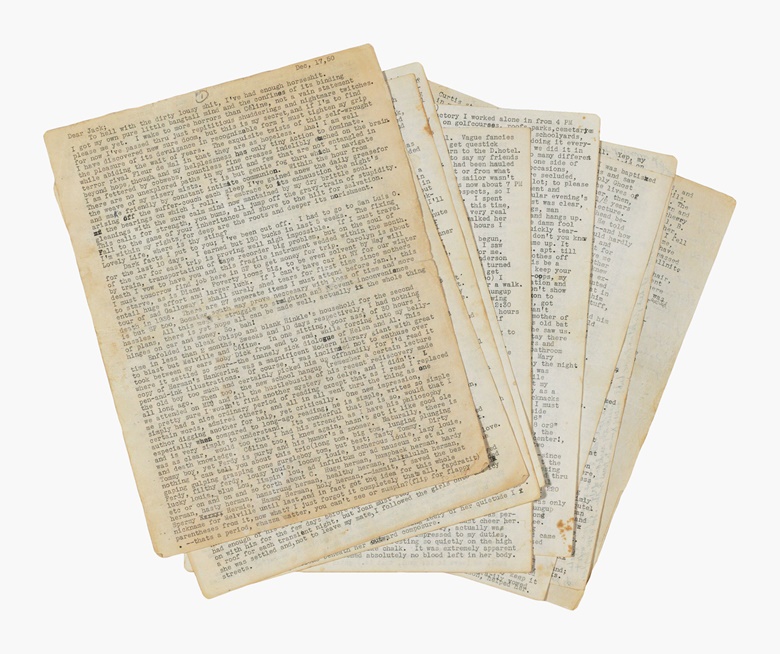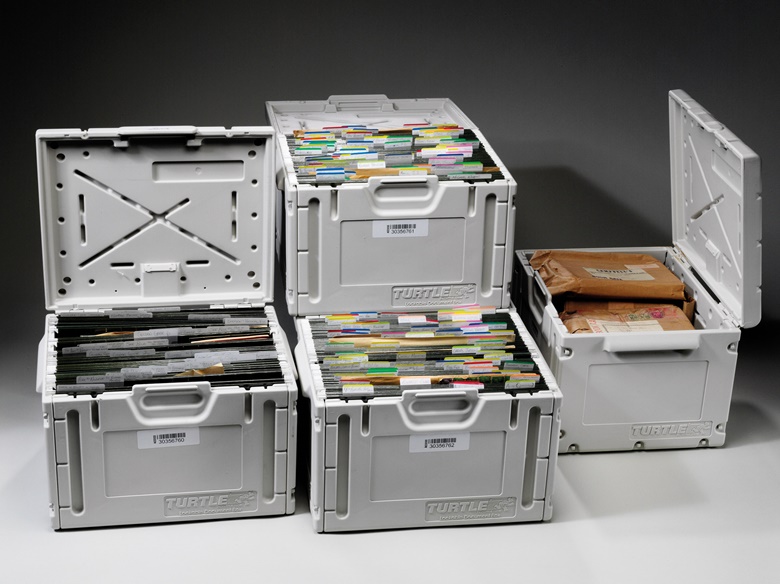 Discovery: The letter Jack Kerouac described as ‘The greatest piece of writing I ever saw’
Discovery: The letter Jack Kerouac described as ‘The greatest piece of writing I ever saw’
Considered ‘lost’ for 66 years, Neal Cassady’s visionary ‘Joan Anderson letter’ is a foundational document of the Beat era and the inspiration for Kerouac’s literary revolutions, beginning with On the Road
Neal Cassady’s long lost letter to Jack Kerouac, dated 17 December 1950, has permeated virtually every conversation about the Beat era. Referenced not only by Kerouac but by Allen Ginsberg, Laurence Ferlinghetti, Herbert Hunke, and a host of their contemporaries, Cassady’s fluid, incantatory, and deeply revealing prose influenced the entire generation of Beat writers.
For enlargements of all images:

The letter was written on a three-day Benzedrine high, Cassady later confessed. It contained, by Kerouac’s first calculation, at least 13,000 words and ran to 40 pages, offering a compelling, unaffected and discursive account of Cassady’s frenetic love life in 1946, particularly with Joan Anderson (whom he visited in a hospital after a failed suicide), and ‘Cherry Mary’, recounting an acrobatic escape through a bathroom window when they were surprised by Mary’s aunt. The uninhibited, non-literary narrative pointed to the way to the free, truthful style to which Kerouac aspired.
Overwhelmed by what he read, Kerouac wrote ecstatically to Cassady on 27 December: ‘I thought it ranked among the best things ever written in America… it was almost as good as the unbelievably good ‘Notes from the Underground’ of Dostoevsky… You gather together all the best styles… of Joyce, Celine, Dosy… and utilize them in the muscular rush of your own narrative style & excitement. I say truly, no Dreiser, no Wolfe has come close to it; Melville was never truer.’

Cassady, Neal (1926-1968). Typed letter completed in autograph and with autograph additions, corrections, and deletions in pencil and pen, to Jack Kerouac (1922-1969), Denver, 17 December 1950. 18 pages, comprising nearly 16,000 words, some pale browning and minor marginal chipping. Estimate: $400,000-600,000. This lot is offered in the Books & Manuscripts sale on 16 June at Christie’s New York. © Cathy Sylvia Cassady, Jami Cassady and John Cassady

© Cathy Sylvia Cassady, Jami Cassady and John Cassady
In an interview published in the Summer 1968 issue of The Paris Review, Kerouac famously hailed the letter’s impact: ‘I got the idea for the spontaneous style of On the Road from seeing how good old Neal Cassady wrote his letters to me, all first person, fast, mad, confessional, completely serious, all detailed, with real names in his case, however (being letters).’
Nearly everyone who knew Cassady was struck by his natural verbal virtuosity as a monologist. Kerouac’s first wife, Joan Haverty Kerouac, recounted his tales of ‘cares and escapades, jail memories and women and nights and blues’, though she was certain that no writing ‘could… capture the vitality and intensity of the voice I now heard, describing everything in such a way that lived it just by listening…’
Never read, or merely neglected, the letter remained untended until its discovery in 2012
As with many documents of the era, the ‘Joan Anderson’ letter travelled a complex path through many hands, and for the majority of the last 66 years was considered lost. After being entranced by it and responding, Kerouac gave the letter to Allen Ginsberg to read and offer to publishers.
Ginsberg then took the letter to his friend Gerd Stern, who was then living in Sausalito on a houseboat and working as a West Coast rep for Ace Books. Within the tight Beat-nexus, Ginsberg and Stern formed a bond after meeting at the mental facility where they were both introduced to (Howl-dedicatee) Carl Solomon. Solomon’s uncle owned Ace Books, and it was Ace that had published William S. Burrough’s Junkie in 1953.

Despite their enthusiasm, Ace rejected publication of Cassady’s typescript and it was returned by Stern to Ginsberg. The letter then went missing and the story was born — perpetuated most emphatically by Kerouac — that it had been lost over the side of Stern’s boat.
In fact, Cassady’s letter had been preserved in the files of the Golden Goose Press. Owned by Ginsberg and Stern’s friend R.W. ‘Dick’ Emerson, the Golden Goose Press was known for publishing some of the finest poets of the period, and for making audio recordings of their readings. Emerson placed the envelope containing the letter on his ‘to read’ pile. Never read, or merely neglected, it remained untended until its discovery in 2012 by Jean Spinosa.
No records of any sales are recorded in the online databases for any Cassady material, let alone for material of this literary consequence
Ginsberg later had no memory of giving the Joan Anderson Letter to Stern, and when Emerson closed the Golden Goose Press the letter was packed further into obscurity. It may have been lost forever had not John ‘Jack’ Spinosa, Emerson’s officemate at 40 Gold Street in San Francisco, insisted on preserving the press’s archives when they were forced to vacate their rental.
Spinosa recognized that literary history was preserved in those files, and saved them from going into the dumpster as Emerson cleared the office. The boxes remained with Jack Spinosa and his wife Kathleen Cohan until after his death on 29 November 2011. On the following 15 May, Jack’s daughter Jean discovered this long-lost monument of post-war American literature, buried within the files of the Golden Goose Press.

Only a fragment of the letter has been published, and that 14 years after it was written and after the great works it influenced had come out. A portion of the letter, apparently copied by Kerouac before giving it to Ginsberg, was published in 1964 by John Bryan in his Notes from Underground #1, where it was called ‘The First Third’. Bryan claimed that Cassady himself came to help print it, while the title suggests that Cassady was by this time considering it as the first portion of his ongoing autobiography.
The same extract was published by City Lights in 1971 as an addendum to Cassady’s book The First Third and later formed the basis of the 1997 film The Last Time I Committed Suicide, directed by Stephen T. Kay, and starring Thomas Jane and Keanu Reeves.

It is an understatement to state that Neal Cassady material is scarce at auction: it is unprecedented. No records of any sales are recorded in the online databases for any Cassady material, let alone for material of this literary consequence. The circumstances of its preservation and appearance at auction constitute a unique opportunity to acquire a foundational post-war literary manuscript that transcends its humble origins as a ‘letter’.

The complete extant archive of the Golden Goose Press, in which was discovered Neal Cassady’s groundbreaking ‘Joan Anderson Letter.’ Sausalito, California, 1950s-60s. Together nearly 200 pamphlets, letters, pieces of ephemera, and related material. A complete list is available on request. Estimate: $10,000-15,000. This lot is offered in the Books & Manuscripts sale on 16 June at Christie’s New York
The letter will travel on a preview tour to Seattle from 31 May to 1 June, San Francisco from 2 to 4 June, Los Angeles from 6 to 9 June, and New York from 11 to 15 June.
